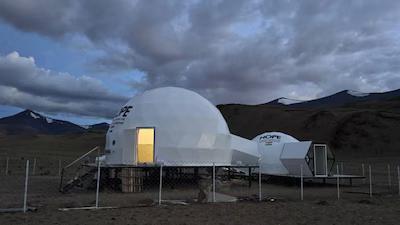
ISRO Sets Up Station in Ladakh to Simulate Life on Moon & Mars
India’s space agency, ISRO, has made a significant step forward in its mission to explore the Moon and Mars by setting up a state-of-the-art station in Ladakh’s Tso Kar Valley. The Himalayan Outpost for Planetary Exploration (HOPE) is a 10-day simulation mission that aims to test life-support systems for future lunar and Martian missions. The unique location was chosen for its extreme climate conditions, which are eerily similar to those found on Mars.
Located at an altitude of 15,000 feet above sea level, the Tso Kar Valley is known for its high UV radiation, low atmospheric pressure, and extreme cold temperatures, making it an ideal location for simulating the harsh environment of Mars. The valley also has saline permafrost, which is a key feature of Martian terrain.
The HOPE station is a mini Mars-like environment that will be populated by two crew members, who will undertake various tests and simulations from August 1 to 10. The crew will be responsible for monitoring and maintaining the life-support systems, including air, water, and food supply, as well as conducting scientific experiments and gathering data.
The simulation mission is designed to test the crew’s ability to work in isolation for extended periods, as well as the performance of the life-support systems in extreme conditions. The data collected during the mission will be crucial in refining the design and operations of future lunar and Martian missions.
ISRO has been working towards sending humans to space for several years now, and the HOPE station is a significant step forward in that direction. The agency has already set up a human spaceflight program, Gaganyaan, which aims to send three Indian astronauts to space by 2022.
The HOPE station is equipped with advanced life-support systems, including air purification, water recycling, and food production. The crew will also be equipped with special clothing and equipment to protect themselves from the harsh environment.
The Tso Kar Valley was chosen for the simulation mission due to its unique combination of extreme climate conditions, which are similar to those found on Mars. The valley’s high UV radiation, low atmospheric pressure, and extreme cold temperatures will provide a realistic simulation of the Martian environment.
The HOPE station is just the beginning of ISRO’s plans to simulate life on other planets. The agency plans to set up more such stations in the future, including one in Antarctica, to simulate the extreme conditions found on Mars and the Moon.
In conclusion, the HOPE station in Ladakh’s Tso Kar Valley is a significant milestone in ISRO’s mission to explore the Moon and Mars. The 10-day simulation mission will provide valuable data and insights into the performance of life-support systems in extreme conditions, paving the way for future human missions to space.






